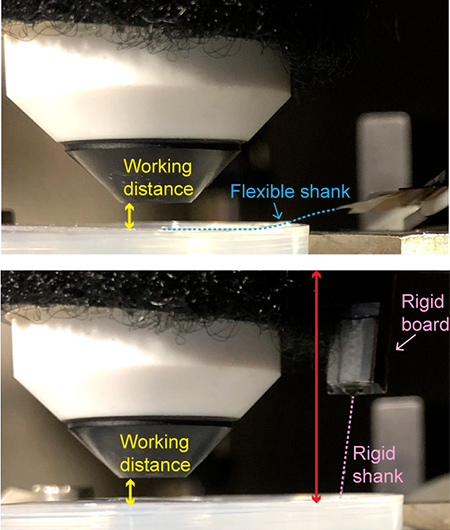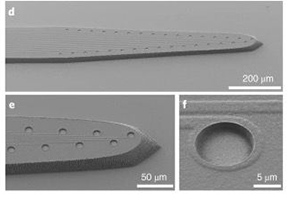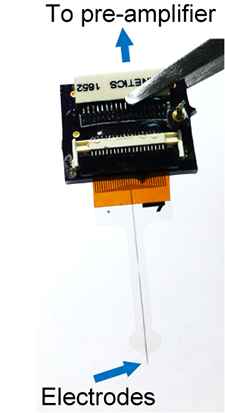The flexible neural probe allows the working distance of the microscope to be close to the surface (top), while a conventional probe with rigid parts makes the working distance (red arrows) much farther (bottom). Credit: Nature Neuroscience
How do different parts of the brain communicate with each other during learning and memory formation? A new study by researchers at the University of California San Diego takes a first step at answering this fundamental neuroscience question.
The study was made possible by developing a neural implant that monitors the activity of different parts of the brain at the same time, from the surface to deep structures—a first in the field. Using this new technology, the researchers show that diverse patterns of two-way communication occur between two brain regions known to play a role in learning and memory formation—the hippocampus and the cerebral cortex. The researchers also show that these different patterns of communication are tied to events called sharp-wave ripples, which occur in the hippocampus during sleep and rest.
The researchers published their findings Apr. 19 in Nature Neuroscience.
"This technology has been developed particularly for studying interactions and communications between different brain regions simultaneously," said co-corresponding author Duygu Kuzum, a professor of electrical and computer engineering at the UC San Diego Jacobs School of Engineering. "Our neural implant is versatile; it can be applied to any area of the brain and can enable study of other cortical and subcortical brain regions, not just the hippocampus and cerebral cortex."
"Little is known about how various brain regions work together to generate cognition and behavior," said Takaki Komiyama, a professor of neurobiology and neurosciences at UC San Diego School of Medicine and Division of Biological Sciences, who is the study's other co-corresponding author. "In contrast to the traditional approach of studying one brain area at a time, the new technology introduced in this study will begin to allow us to learn how the brain as a whole works to control behaviors and how the process might be compromised in neurological disorders."
The neural implant is made up of a thin, transparent, flexible polymer strip fabricated with an array of micrometer-sized gold electrodes, onto which platinum nanoparticles have been deposited. Each electrode is connected by a micrometers-thin wire to a custom-printed circuit board. Kuzum's lab developed the implant. They worked with Komiyama's lab to perform brain imaging studies in transgenic mice.
SEM images of the neural implant's microelectrode array. Credit: Nature Neuroscience
Engineering a multi-use neural probe
What makes this neural implant unique is that it can be used to monitor activity in multiple brain regions at the same time. It can record electrical signals from single neurons deep inside the brain, like in the hippocampus, while imaging large areas like the cerebral cortex.
"Our probe enables us to combine these modalities in the same experiment seamlessly. This cannot be done with current technologies," said Xin Liu, an electrical and computer engineering Ph.D. student in Kuzum's lab. Liu is a co-first author of the study along with Chi Ren, a recent UC San Diego biological sciences Ph.D. graduate who is now a postdoctoral researcher in Komiyama's lab, and Yichen Lu, an electrical and computer engineering Ph.D. student in Kuzum's lab.
Several design features make multi-region monitoring possible. One is that this probe is flexible. When it is inserted deep into the brain to monitor a region like the hippocampus, the part that sticks out of the brain can be bent down and make room for a microscope to be lowered close to the surface to do imaging of the cerebral cortex at the same time. Conventional neural probes are rigid, so they get in the microscope's way; as a result, they cannot be used to monitor deep brain structures while imaging the brain's surface. And even though the UC San Diego team's neural probe is soft and flexible, it is engineered to withstand buckling under pressure during insertion.
Another important feature is that this probe is transparent, so it gives the microscope a clear field of view. It also does not generate any shadows or additional noise during imaging.
The neural implant connected to a customized printed circuit board. Credit: Nature Neuroscience
Exploring fundamental neuroscience questions
The motivation for this study was getting to the root of how different cognitive processes, such as learning and memory formation, occur in the brain. Such processes involve communication between the hippocampus and cerebral cortex. But how exactly does this communication happen? And which brain region initiates this communication: the hippocampus or the cerebral cortex? These types of questions have been left unanswered because it is very difficult to study these two brain regions simultaneously, said Kuzum.
"We were interested in investigating the nature of cortical-hippocampal interactions, so we built a technology to explore this neuroscience problem," she said.
The researchers used their probe to monitor the activity of the hippocampus and the cerebral cortex in transgenic mice. Specifically, they monitored activity before, during and after oscillations that occur in the hippocampus called sharp-wave ripples.
Their experiments revealed that communication between the hippocampus and cerebral cortex is two-sided: sometimes the cortex initiates communication, other times it's the hippocampus. This is an important first clue for understanding inter-region communication in the brain, the researchers said.
"The hippocampal-cortical interaction is important in memory consolidation and retrieval," said Ren. "The two-sided communication we reported here is different from the conventional notion that the cortex passively receives the information from the hippocampus. Instead, the cortex is actively involved in encoding information into the brain and may play an instructive role during memory consolidation and retrieval."
"We can now begin new studies to unlock how processes like learning and memory happen," said Kuzum. "For example, when the brain acquires new information, how does the hippocampus transfer the memory to the cortex for storage, or does the cortex send a cue to transfer the memory? Our findings show that communication can be initiated by either, but to go beyond that we'd need to do behavioral studies."
This study also reveals that there are diverse and distinct modes of communication between the hippocampus and the cerebral cortex. The researchers found that the hippocampus communicates with at least eight different parts of the cerebral cortex every time sharp-wave ripples occur. Further, each of these eight cortical activity patterns is tied to a different population of neurons in the hippocampus.
"These findings suggest that the interactions between brain regions, not only between cortex and hippocampus, can be fundamentally diverse and flexible. Therefore, multiple brain regions can efficiently work together to generate cognition and behavior that rapidly adapt to changing environments," said Ren.
More information: Xin Liu et al, Multimodal neural recordings with Neuro-FITM uncover diverse patterns of cortical–hippocampal interactions, Nature Neuroscience (2021). DOI: 10.1038/s41593-021-00841-5
Journal information: Nature Neuroscience
Provided by University of California - San Diego

























